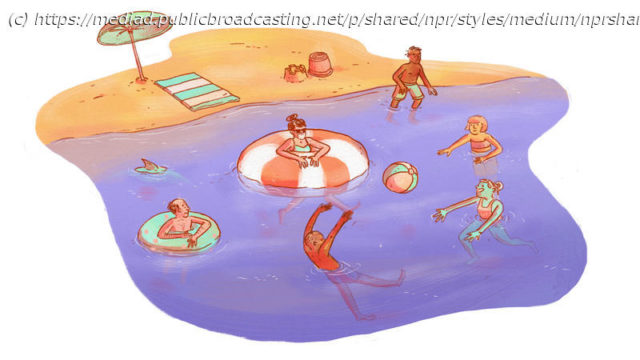It’s been around two months of quarantine for many of us. The urge to get out and enjoy the summer is real. But what’s safe? We asked a panel of
It’s been around two months of quarantine for many of us. The urge to get out and enjoy the summer is real. But what’s safe? We asked a panel of infectious disease and public health experts to rate the risk of summer activities, from backyard gatherings, to a day at the pool, to sharing a vacation house with another household.
One big warning: Your personal risk depends on your age and health, the prevalence of the virus in your area, and the precautions you take during any of these activities. Also, many areas continue to restrict the activities described here, so check your local laws.
And there’s no such thing as a zero-risk outing right now. As states begin allowing businesses and public areas to reopen, decisions about what’s safe will be up to individuals. It can help to think through the risks the way the experts do.
«We can think of transmission risk with a simple phrase: time, space, people, place,» explains Dr. William Miller, an epidemiologist at Ohio State University.
Here’s his rule of thumb: The more time you spend and the closer in space you are to any infected people, the higher your risk. Interacting with more people raises your risk, and indoor places are riskier than outdoors.
Dr. Emily Landon, hospital epidemiologist and infectious diseases specialist at University of Chicago Medicine, has her own shorthand: «Always choose outdoors over indoor, always choose masking over or not masking, and always choose more space for fewer people over a smaller space.»
Our experts shared their thoughts via phone and e-mail interviews.
Jump to an activity:Backyard gathering; Restaurant; Worship service; Beach or pool; Outdoor party; Public restroom;A friend using your bathroom; Vacationing with another family; Haircut; Shopping mall; Hotel; Camping; Nightclub; Outdoor sports
Meeting in a spacious outdoor area with only a small group isn’t too risky. But our experts say that safety here depends on who you invite and what their behaviors have been. «If you have a gathering with one other household that [has] followed social distancing, this would be a low-risk activity,» says Dr. Judith Guzman-Cottrill, a pediatric infectious disease expert at Oregon Health & Science University.
What alters risk? To lower risk, avoid sharing food, drinks or utensils — make it a BYO everything party. Dr. Andrew Janowski, a pediatric infectious diseases expert at Washington University in St. Louis, notes the food itself isn’t the risk, but touching shared dishes or utensils could be.
Watch out for drinking, says Dr. Abraar Karan, a physician and public health researcher at Harvard Medical School, as it can make people sloppy about social distancing. It also increases the odds that people will want to use your bathroom. «Once you move into the house with others, the risk profile goes up,» he says.
Some experts suggest wearing a face covering, but Landon points out that you can’t realistically stay masked while eating and drinking. She suggests an alternative to a meal would be a backyard lawn tournament: That way, «the kids can play together, but still with their masks on.» It could be fun for the grownups too.
Indoor dining «is still amongst the riskier things you can do,» Landon warns. The trouble is, says Miller, «people tend to linger in restaurants. So even if spacing is okay, the duration of exposure is longer.» Also, he says, talking «appears to lead to some release of the virus.»
Karan notes that one outbreak in Guangzhou, China took place in a restaurant with no windows and poor ventilation, and the air conditioning appears to have blown droplets between tables.
What alters risk? Janowski says the risk level depends on how well the restaurant has adapted for the pandemic. Eateries should reduce and space out seating, require servers to wear masks, and offer easy access to hand-washing stations.
They should also provide single-use options for condiments so you don’t have to touch shared ones, says Janowski. And they should close all self-serve areas like soda fountains or buffet tables.
If you do go to a restaurant, look for outdoor seating. Landon says she would only go with members of her household, because «I don’t want to have to take my mask off in the close proximity of a bunch of other people.»
Worship services involve people from different households coming together indoors, for an extended time. «All of the ingredients are there for the potential for a lot of people becoming infected in the short amount of time,» says Kimberly Powers, an epidemiologist at the University of North Carolina at Chapel Hill. She points to outbreaks linked to churches: In one, 35 out of 92 people who attended a service at a rural Arkansas church developed COVID-19.
Singing — whether from the pews or the choir — is high risk, several experts noted, citing a study of a choir practice in Washington state where over half of attendees became infected.
What alters risk: If people are appropriately socially distanced, wear masks and avoid singing, it may reduce the risk, Karan says. Also avoid any shared worship items like hymnals, Janowski adds.
Risk goes down if places of worship adapt, Guzman-Cottrill says. «My parish began having in-person services last week,» she says. The church had advance sign-ups to limit attendance to 25 people. Attendees were required to be healthy, wear face coverings and sit at least six feet apart.
As long as you can stay socially distanced, this could be a pretty safe activity, our experts say.
Домой
United States
USA — Financial From Camping To Dining Out: Here's How Experts Rate The Risks Of...






